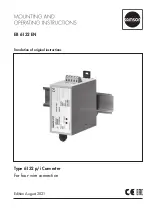
Tel: +86-755-29644311 Fax: +86-755-29644383 Email: sales@gemsnav.com Web: www.gemsnav.com
Document Number 120229 Rev 003 2017-03-03
Page 2 / 16
Description
The
iRGS232
GPS
Splitter
is
a
dual
‐
input,
thirty
two
‐
output
GPS
device.
The
dual
input
ports
connect
two
GPS
receive
antennas.
The
outputs
ports
grant
up
to
32
GPS
receives
signal
access
at
one
time.
When
entering
the
GNSS
signal
system
management
terminal
to
set
the
IP,
the
software
can
display
the
power
of
each
port,
the
number
of
GPS
visible
satellites
and
the
value
of
C
/
No,
the
number
of
Beidou
visible
satellites
and
the
value
of
C
/
No.
This
product
typically
finds
application
where
an
input
from
an
active
GPS
roof
antenna
is
split
evenly
between
thirty
two
receiving
GPS
units.
Usually
the
iRGS232
is
configured
with
an
12V
input
(
‐
48V
telecom
power
input
also
available).
In
this
scenario,
the
iRGS232
can
be
configured
to
pass
DC
from
an
RF
output
to
the
antenna
input
port
in
order
to
power
an
active
GPS
antenna
on
that
port.
Output
ports(J2
‐
J32)
would
feature
a
200
Ohm
DC
load
to
simulate
an
antenna
DC
current
draw
for
any
receiver
connected
to
those
ports.
Redundancy
is
acquired
through
the
use
of
a
primary
antenna
and
a
backup
antenna.
The
ability
of
the
iRGS232
to
switch
antennas
allows
all
connected
GPS
devices
to
remain
fully
functional
in
the
event
of
an
antenna
failure.
The
iRGS232
can
manually
or
automatically
switch
the
antenna
port.
Faults
are
indicated
on
the
front
panel
LED
and
status
via
a
DB9
interface.
Within
the
iRGS232
is
an
antenna
health
sensor
and
an
embedded
antenna
switch.
The
sensor
monitors
the
health
of
the
primary
antenna
connected
to
the
splitter.
Based
on
the
information
provided
by
the
sensor,
the
splitter
will
automatically
switch
to
the
secondary
antenna
in
the
event
of
a
failure
with
the
primary
antenna.
If
the
failure
in
the
primary
antenna
is
resolved,
the
splitter
will
automatically
switch
back
to
the
primary.
The
embedded
switch
has
been
designed
so
it
can
be
controlled
externally
via
a
DB9
port
or
an
external
toggle
switch
that
can
override
the
internal
automatic
switch
mechanism
.
Antenna
selection
description
Powered
hardware,
the
software
began
to
calculate
the
signal
strength
of
antenna
1and
antenna
2,
after
comparing
the
intensity
of
the
two
input
signals
automatically
select
the
high
signal
intensity
of
the
antenna
input.
When
two
input
antennas
strength
less
than
34dB,
according
to
the
number
of
switches
and
the
switching
frequency
of
switching
continues
until
the
switching
frequency
greater
than
140
times.
When
started
with
a
good
choice
of
antenna,
the
system
continues
to
signal
detection,
when
the
signal
strength
is
too
low
or
the
antenna
failure,
the
automatic
starting
antenna
selection
logic.
Holding
the
antenna
1
priority,
it
can
delay
the
service
life
of
the
equipment.
Note:
Switching
times:
Each
antenna
switch
once
switches
the
number
of
plus
1
time.
Switching
frequency:
Switch
the
number
of
times
less
than
ten
times,
then
switch
once
every
minute.
Switching
times
greater
than
10
times
less
than
140
times
,
every
ten
minutes
to
switch
once.


































